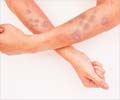Detecting HIV, Hepatitis B, and Hepatitis C virus is easy with a new ground-breaking new test that uses nothing more than a single drop of blood.

New Test Needs Just One Drop of Blood to Detect HIV and Hepatitis
The most common test for hepatitis B, hepatitis C, and HIV involves taking a blood sample from a vein using a needle. While this method works extremely well, there is a potentially large reservoir of the three conditions in places where this method is not suitable.TOP INSIGHT
A test using a single spot of dried blood successfully detected HIV, hepatitis B, and hepatitis C in all 60 samples with known amounts of each virus.
Alternatives include dried blood spot tests, in which a single spot of blood is tested for nucleic acid from the three viruses. Researchers at the Department of Clinical Microbiology, Copenhagen University Hospital, Denmark validated (assessed) one such test.
To do the test, the individual’s finger is pricked and a few spots of blood are collected on filter paper and allowed to dry. The Hologic Panther System – testing equipment widely found in public health laboratories – then uses a technique called transcription-mediated amplification to analyze one of the blood spots for genetic material from the three viruses.
The analysis is designed to be, and is normally, run on liquid samples of plasma or serum – not the dried samples used here. Twenty samples with known amounts of HIV, hepatitis B, and hepatitis C were analyzed via the dried blood spot method (60 in total), and the viruses were detected in all the samples.
The plasma was also diluted to determine the lower limit of detection. This showed that it was possible to detect the viruses at levels that are much lower than are normally found in untreated patients.
 MEDINDIA
MEDINDIA




 Email
Email










